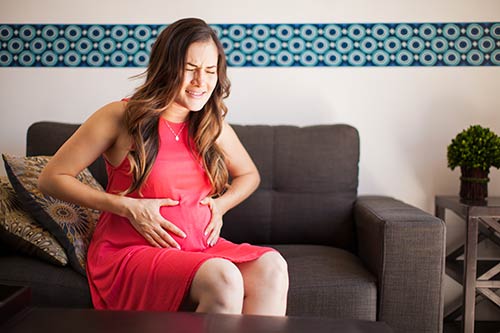Signs of Labor

Rosemark’s obstetricians and certified nurse-midwives will instruct patients what to do when they think labor has begun. It can be difficult to identify labor as contractions which may seem regular first subside and only happen occasionally. A couple of things to know:
- Labor is defined as contractions with cervical change, or cervical dilation.
- Contractions occur when the muscles of the uterus tighten and relax as the uterus prepares for delivery.
False Labor Contractions
False labor also known as Braxton-Hicks contractions often occur during the last month of pregnancy but can happen at any time. A few key indicators that you are experiencing false labor include:
- Contractions are irregular.
- Contractions do not get closer together and may stop after about an hour.
- The contractions stop with walking, activity, or warm baths and relaxation.
- The contractions do not intensify or become more painful.
- The cervix does not change.
Signs of Labor
Early signs of labor can be different for every woman so while there are some general guidelines, there can be differences.
Some signs that labor is near include:
- The baby settling into the pelvis which is called “dropping” or “lightening.”
- The cervix could begin to efface (thin) and open (dilate).
- Water may “break.” This is a rupture of the membranes of the amniotic sac and if it happens, call your obstetrician or certified nurse-midwife right away.
The key to knowing true labor has begun is when you experience the following with your contractions:
- Contractions occur at regular intervals and typically last 30 – 60 seconds.
- The contractions get closer together.
- The contractions become longer and stronger and become more painful over time.
- Contractions may be felt in the lower abdomen and in the lower back.
- The contractions continue or increase in intensity when walking or during activity.
- The contractions cause cervical change, including softening, thinning and dilation.
After a while it will become hard to talk during a contraction. Many women will stay at home during early labor but it is important to know when to call the doctor or certified nurse-midwife.
What to Do when Labor Starts
If you think you are in labor, you should collect your hospital bag and be prepared to call our office or go to the Labor and Delivery department of the hospital. Things to do include:
- Rest and, if possible, lay down on your left side.
- Time your contractions with a watch. If one contraction starts at 11:01, and the next one starts at 11:08, the contractions are 7 minutes apart.
- Call our office or go to Labor and Delivery when the contractions are:
-
- Consistent for two hours and are 5-minutes apart or less.
- Increase in pain and severity over time.
When Should I go to the Hospital?
Call your doctor or certified nurse-midwife or go to the hospital’s Labor and Delivery department immediately in the following situations:
- Any vaginal bleeding occurs.
- There is a sudden release of fluid from your vagina.
- Regular contractions have been sustained for an hour. This means about 4 or more contractions in 20 minutes or about 8 or more in 1 hour.
- You have pelvic pressure or back pain that does not go away.
- The baby has stopped moving or is moving less than normal. Count the number of kicks which may be about 10 kicks or movements in 1 hour. Less than 10 kicks in the second hour will necessitate a call your provider right away.
When Should I call 911?
Anytime during early labor, someone should call 911 immediately if the need for emergency care is detected as in situations like severe vaginal bleeding or severe pain in the belly or pelvis.
Be Safe and Communicate
During early labor or anytime during the pregnancy, patients should call their doctor or certified nurse-midwife if they have a question or concern no matter how simple or senseless it may seem. Rosemark is here to help!
